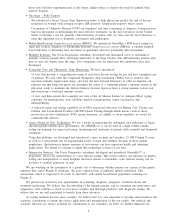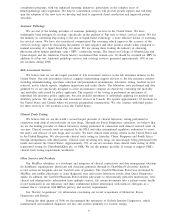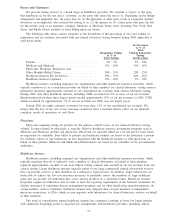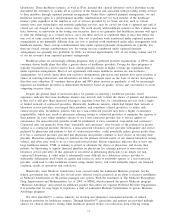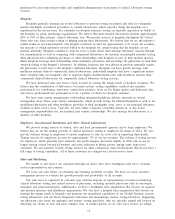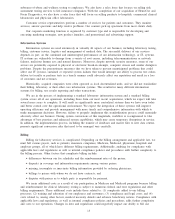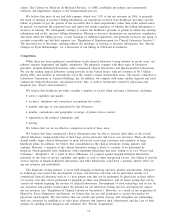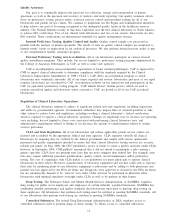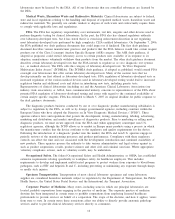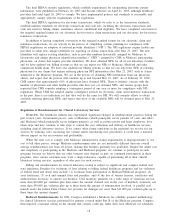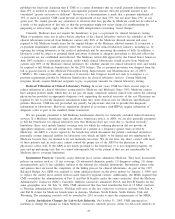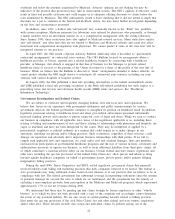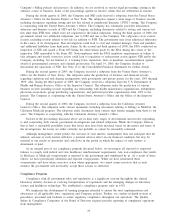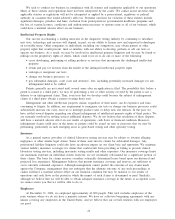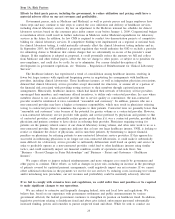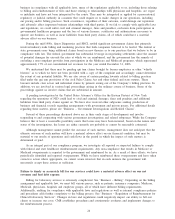Quest Diagnostics 2006 Annual Report Download - page 39
Download and view the complete annual report
Please find page 39 of the 2006 Quest Diagnostics annual report below. You can navigate through the pages in the report by either clicking on the pages listed below, or by using the keyword search tool below to find specific information within the annual report.The final HIPAA security regulations, which establish requirements for safeguarding electronic patient
information, were published on February 20, 2003 and became effective on April 21, 2003, although healthcare
providers had until April 20, 2005 to comply. We have implemented policies and standards to reasonably and
appropriately comply with the requirements of the regulations.
The final HIPAA regulations for electronic transactions, which we refer to as the transaction standards,
establish uniform standards for electronic transactions and code sets, including the electronic transactions and
code sets used for billing claims, remittance advices, enrollment and eligibility. We have completed conversion to
the required standard format for our electronic fee-for-service claim transactions and our electronic fee-for-service
remittance transactions.
In addition to having completed conversion to the required standard format for our electronic claim and
remittance transactions, we are actively in the process of completing systems planning for compliance with
HIPAA regulations on adoption of national provider identifiers (“NPI”). The NPI regulations require health care
providers to adopt new, unique identifiers for reporting on claims transactions after May 23, 2007. The new
identifiers will replace existing identifiers, such as provider numbers historically assigned by Medicare to
laboratories and unique physician identification numbers (“UPIN”) assigned by CMS to Medicare participating
physicians, on claims that require provider identifiers. We have obtained NPIs for all of our laboratory facilities
and we have updated our billing systems so that we can report our NPIs to Medicare, Medicaid and other
commercial health plans. We have also updated our billing systems so that we can report the NPIs of referring
physicians for our claims that require referring physician NPI information after May 23, 2007, such as claims
submitted to the Medicare program. We are in the process of obtaining NPI information from our physician
clients, and expect that the process will continue up to and beyond May 23, 2007. As of February 23, 2007,
CMS reports that approximately 60% of physicians have obtained NPIs. There is industry concern with the
number of physicians and other health providers who have not yet obtained NPIs, and various groups have
requested that CMS consider adopting a contingency period of one year or more for compliance with NPI
regulations. While CMS has adopted similar contingency periods for electronic claim and remittance transactions
in the past, there is no indication yet that they will do the same for NPI. We will continue efforts to obtain
available referring physician NPIs, and expect that most of the available NPIs will be obtained prior to May 23,
2007.
Regulation of Reimbursement for Clinical Laboratory Services
Overview. The healthcare industry has experienced significant changes in reimbursement practices during the
past several years. Government payers, such as Medicare (which principally serves patients 65 years and older)
and Medicaid (which principally serves indigent patients), as well as private payers and large employers, have
taken steps and may continue to take steps to control the cost, utilization and delivery of healthcare services,
including clinical laboratory services. If we cannot offset future reductions in the payments we receive for our
services by reducing costs, increasing test volume and/or introducing new procedures, it could have a material
adverse impact on our net revenues and profitability.
While the total cost to comply with Medicare administrative claims requirements is disproportionate to our
cost to bill other payers, average Medicare reimbursement rates are not materially different than our overall
average reimbursement rate from all payers, making this business generally less profitable. Despite the added cost
and complexity of participating in the Medicare and Medicaid programs, we continue to participate in such
programs because we believe that our other business may depend, in part, on continued participation in these
programs, since certain customers may want a single laboratory capable of performing all of their clinical
laboratory testing services, regardless of who pays for such services.
Billing and reimbursement for clinical laboratory testing is subject to significant and complex federal and
state regulation. Penalties for violations of laws relating to billing federal healthcare programs and for violations
of federal fraud and abuse laws include: (1) exclusion from participation in Medicare/Medicaid programs; (2)
asset forfeitures; (3) civil and criminal fines and penalties; and (4) the loss of various licenses, certificates and
authorizations necessary to operate our business. Civil monetary penalties for a wide range of violations are not
more than $10,000 per violation plus three times the amount claimed and, in the case of kickback violations, not
more than $50,000 per violation plus up to three times the amount of remuneration involved. A parallel civil
remedy under the federal False Claims Act provides for damages not more than $11,000 per violation plus up to
three times the amount claimed.
Reduced Reimbursements. In 1984, Congress established a Medicare fee schedule payment methodology
for clinical laboratory services performed for patients covered under Part B of the Medicare program. Congress
then imposed a national ceiling on the amount that carriers could pay under their local Medicare fee schedules.
18


